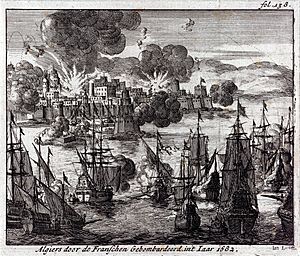Bombardment of Algiers (1682) facts for kids
Quick facts for kids Bombardment of Algiers, 1682 |
|||||||
|---|---|---|---|---|---|---|---|
| Part of French-Algerian War 1681-88 | |||||||
 Bombardment of Algiers by the fleet of Admiral Duquesne in 1682 |
|||||||
|
|||||||
| Belligerents | |||||||
| Commanders and leaders | |||||||
| Abraham Duquesne | Baba Hassan | ||||||
| Units involved | |||||||
| 11 ships of the line 15 galleys 5 bomb galiots 2 fireships other small vessels |
unknown | ||||||
| Casualties and losses | |||||||
| unknown | 500 dead | ||||||
The Bombardment of Algiers in 1682 was a big naval attack. It happened when France fought against the Regency of Algiers. This was part of the French-Algerian War.
King Louis XIV of France sent Admiral Duquesne to attack Algiers. This happened after the ruler of Algiers, called the Dey, declared war on France in 1681. Admiral Duquesne sailed from Toulon with many ships. He reached Algiers in July 1682, but bad weather caused many delays.
The city was bombed several times in August. It suffered a lot of damage. However, Algerian ships were able to move around and threaten the French. Also, bad weather forced Duquesne to go back to France.
Contents
Why Did the Bombardment Happen?
In October 1680, some French ships were captured. This happened without a war being declared. The people on these ships were taken to Algiers as prisoners.
On October 18, the ruler of Algiers, Dey Baba-Hassan, officially declared war on Louis XIV. A few days later, he told the French consul, Jean Le Vacher, that fighting would begin. He also sent twelve warships out to sea.
When King Louis XIV heard about this, he ordered his officials to get ready for a strong response.
France Prepares for Battle
The French king chose Admiral Duquesne to lead the attack. Comte de Tourville was his second-in-command.
The French fleet was very strong. It included:
- 11 large warships (called ships of the line)
- 15 galleys (ships moved by oars)
- 5 bomb galiots (new ships that could fire bombs)
- 2 fireships (ships filled with flammable materials to set enemy ships on fire)
- Other smaller boats
The bomb galiots were a new invention. They were strongly supported by Colbert, a French minister. This was their first time being used in a real battle.
Admiral Duquesne left Toulon on July 12. He led eleven warships and five bomb galiots.
|
|
On July 18, Duquesne stopped at Ibiza. There, he met up with fifteen galleys. These galleys were led by the duc de Mortemart.
|
|
The Attack on Algiers
The French fleet arrived at Algiers on July 22, 1682. Admiral Duquesne's orders were to bomb Algiers until it surrendered completely.
First, he sent some ships to burn two Turkish ships in the port of Cherchell. Then, he arranged his ships to attack Algiers. His galleys helped pull the warships and bomb galiots into position.
Challenges and Adjustments
The weather was very bad during the first half of August. This stopped Duquesne from starting the attack. On August 15, he sent his galleys back to Marseille. Their crews were tired of the terrible conditions.
This made it harder for the bomb galiots to move. To help them, longboats carried five anchors close to the city. These anchors were connected to the galiots by long cables. This allowed the galiots to pull themselves closer to the city.
On August 16, the longboats dropped their anchors near the mole (a harbor wall). The galiots then pulled themselves into position. However, the French were not ready to start bombing until the night of August 20.
The first attack was not very effective. The bomb galiots were too far from their targets. The captains had misjudged the distance.
Intense Bombardment
The French decided to move their ships to the northwest of the city. On the night of August 20–21, two ships were anchored closer. The next night, three more ships were brought even closer.
The captain of the bomb galiots, Landouillette, fired the mortars himself. But the bombs barely reached the mole and did not hit the city. On August 26, they adjusted their positions again.
After this, they bombed the city very strongly until September 5. This caused serious damage to the port and the city.
The second night of bombing was August 30. The galiots pulled themselves even closer to the mole. On the third night, September 3–4, the galiots were even closer. The next night, Duquesne sent them within 400–520 meters of the mole. They were about 800 meters from the city wall.
That night, they fought off an attack by an Algerian galley and other small boats. On September 4, the Dey sent Jean Le Vacher to Duquesne to ask for peace. Duquesne said that if Algiers wanted peace, they should present their ideas themselves. He also warned that he still had thousands of bombs to fire if their ideas were not good enough.
French Retreat
On September 13, the Algerian pirate captains managed to move their ships. This made them a threat to the French position. Soon after, the bad weather made it impossible for the French to stay. They had to stop the bombing and go back to France.
What Happened Next?
About 500 Algerians were killed during the bombardment. Fifty buildings were destroyed.
The next year, Admiral Duquesne sailed to Algiers again. He bombed the city for a second time. You can read about it here: Bombardment of Algiers (1683).


